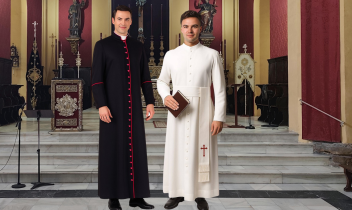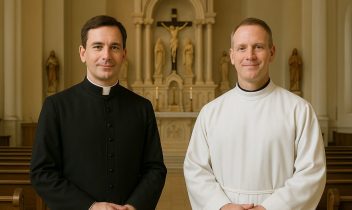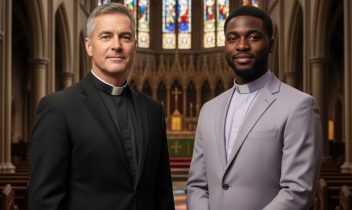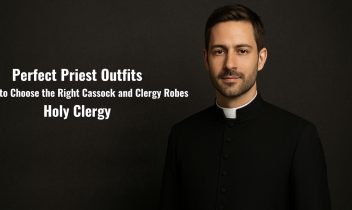No products in the cart.
Return To Shop
When you step into a church and see a priest dressed in special clothing, you might wonder, “What is the cloth that priests wear, and what do they mean?” Many people have questions about these clothes and the meanings they hold.
These garments, often called vestments or Cassock, have been part of church life for centuries. They’re not just clothing; they symbolize deep connections to faith and tradition. Each piece, from flowing robes to simple stoles, has its own story and purpose in worship.
Understanding why these clothes matter can be tricky, but learning about them helps us see the unique role they play in church life.
Want to know more about these traditional garments, their history, and what they look like today? Let’s explore the world of priest clothing and discover what makes each piece meaningful!
Understanding Priestly Clothing
Priestly clothing refers to the attire worn by priests while performing religious duties, especially in Christian liturgical settings. These garments serve both functional and symbolic purposes, signifying the priest’s dedication to the sacred and their connection to God. Let’s break down the different parts of priest clothing and their meanings.
what do you call the priest clothes?
The term priest clothing encompasses various garments worn by religious leaders during ceremonies and rituals. The names of these garments may differ across denominations, but their roles remain largely consistent. Let’s explore some of the most common Priest clothing names and their historical significance:
Cassock:
This long, ankle-length robe, typically black, is one of the most identifiable pieces of priest clothing. The cassock symbolizes humility, service, and the priest’s devotion to God. It’s worn by priests of many Christian denominations, and in some, it’s also known as a clerical robe.
Alb:
A white robe worn by priests over their cassock, the alb signifies purity and spiritual cleanliness. It’s an essential part of priest clothing for Mass, representing the priest’s readiness to serve at the altar.
Chasuble:
This is the outer garment worn by priests during the celebration of Mass. It’s typically colorful and signifies the priest’s role as a celebrant of the Eucharist. The color of the chasuble changes according to the liturgical season, with red, white, green, and purple being the most common.
Surplice:
The stole is a narrow strip of cloth worn over the shoulders, usually placed around the neck. It symbolizes the priest’s authority and is often worn during sacraments and rites, including baptism, marriage, and the Eucharist.
Zucchetto:
A small skullcap worn by clergy members, especially bishops, the zucchetto signifies the priest’s spiritual role and is typically worn in conjunction with other vestments during Mass or prayers.
Cincture:
The cincture is a rope-like belt worn over the cassock or alba. It ties around the waist and holds the garment in place, often symbolizing chastity and readiness for service.
Roman Collar:
The Roman collar, often referred to as a clerical collar, is a distinctive white collar worn by many priests, particularly in the Roman Catholic Church. It’s a symbol of their clerical status and authority.
These are the most common priest clothes names, but the exact attire can differ depending on the denomination or church tradition. Each piece of clothing holds symbolic significance and represents the priest’s commitment to his religious vocation.
Priest Clothing in the Bible
Priest clothing has deep roots in the Bible, especially in the Old Testament. In the high priest clothes in the Bible, the garments were described in great detail to symbolize purity, righteousness, and spiritual authority. For example, in the Book of Exodus (28:2), it is stated that Aaron, the first high priest, was commanded to wear specific garments to show his divine selection and purpose.
Some key biblical references to priest clothes in the Bible include:
High Priest’s Garments:
The high priest wore a special attire consisting of a breastplate, a robe, a tunic, a sash, and a crown. These garments were designed to represent the holiness and sanctity required of the high priest.
Priestly Tunic and Mitre:
In the high priest clothes Bible, there were specific instructions regarding the mitre (a type of headgear) and tunics, symbolizing the priest’s dedication to God.
Priestly Vestments:
The priest clothing parts mentioned in the Bible emphasize purity and sanctity. The garments were not only worn for religious duties but also to distinguish the priest from ordinary people.
The significance of priest clothes in the Bible is clear: they symbolize both divine appointment and the responsibility to lead people in worship and faith.
Medieval Priest Clothes
Medieval priest clothes were characterized by distinctive, symbolic garments that varied depending on the period, region, and the specific role of the priest. These garments were designed not only for practical use but also to reflect the sacred nature of the priesthood. Priest clothing in the medieval era was heavily influenced by the Church’s authority, religious symbolism, and the need to differentiate the clergy from the laity. Here is a closer look at medieval priest clothes:
- Chasubles: These were often highly decorative and embellished with intricate embroidery or gold thread, signifying the divine nature of the Mass.
- Albs: Medieval albs were made from luxurious fabrics like silk and were often trimmed with lace or gold, signifying the purity and holiness of the priest who wore them.
- Stoles: The stole worn during medieval times was often long and embroidered with religious symbols. It was considered a sign of authority and spiritual power.
- Mitres: A distinct feature of the medieval period, bishops often wore mitres (pointed, ceremonial headpieces) as part of their episcopal priest clothing.
While many of these garments have undergone changes over the centuries, the essence of their symbolism remains intact in modern priestly clothing.
Episcopal Priest Clothing
Episcopal priest clothing is worn by clergy in the Episcopal Church, an Anglican denomination. The Episcopal priest clothing includes similar garments to those in the Roman Catholic Church, such as the cassock, alb, chasuble, and stole. However, the design and use of certain garments may vary slightly based on tradition and regional practices.
- Cassocks are typically black in color, although other colors can be worn for special occasions.
- Albs are white and are worn during worship services, representing the purity of the priest.
- Chasubles in the Episcopal Church may vary in style but still follow the same basic principles as those in other liturgical traditions.
Priest Clothing for Mass
When priests are preparing for Mass, they wear specific priest clothing for Mass to symbolize their authority and the sanctity of the occasion. The main garments for priest clothes for Mass include:
- Cassock: The priest begins by wearing the cassock, which symbolizes humility and devotion.
- Alb: Over the cassock, the priest wears the alb to represent purity and spiritual cleanliness.
- Stole: The priest wears the stole over the alb to signify authority and the responsibility to perform sacramental duties.
- Chasuble: Finally, the chasuble is worn to symbolize the priest’s role as the celebrant of the Eucharist.
Where Do Priests Get Their Clothes?
Priests often purchase their attire from specialty stores that provide clergy garments and priest clothing. There are a variety of sources where priests buy their clothes, both online and in physical stores. Many Catholic and Christian stores offer a wide range of priest clothing for Mass, from basic cassocks to elaborate chasubles and stoles.
For those looking for quality priest clothing, online retailers like Clergy Wear Shop offer a vast selection of clergy attire for various occasions, ensuring priests have access to garments that align with their liturgical traditions.
Conclusion
Priestly clothing is a rich blend of symbolism, tradition, and practical function. Each garment has been carefully designed over centuries to represent the spiritual authority and purity of the clergy. Whether it’s the simple humility of the cassock or the intricate beauty of the chasuble, priest clothing helps convey the sacred role priests play in religious ceremonies. From priest clothing in the Bible to modern-day liturgies, these garments continue to hold deep significance, offering a visual representation of faith, service, and devotion.
For those interested in purchasing priest attire, online stores like Clergy Wear Shop offer a variety of options to suit different denominations, ensuring priests have access to quality vestments that reflect their sacred duties.
Frequently Asked Questions (FAQs) on What is the Cloth that Priests Wear called
What are priest clothes called?
Priest clothes are often referred to as vestments or priestly clothing. The garments include the cassock, alb, stole, chasuble, and other liturgical attire.
Where do priests buy their clothes?
Priests typically purchase their clergy attire from specialty stores that provide liturgical garments, both online and in brick-and-mortar locations.
What is the significance of priestly clothing?
Priestly clothing symbolizes the priest’s dedication to God, purity, authority, and their sacred role in performing rituals and ceremonies.
Are there different types of priest clothing for different occasions?
Yes, priests wear specific clothing for different occasions. Cassock is worn daily, while the chasuble and stole are worn while Mass and other liturgical ceremonies.
Where can I buy priest clothing?
You can buy priest clothing at various online stores, such as Clergy Wear Shop, which offers a wide range of clergy garments suitable for different occasions.








Recent Comments